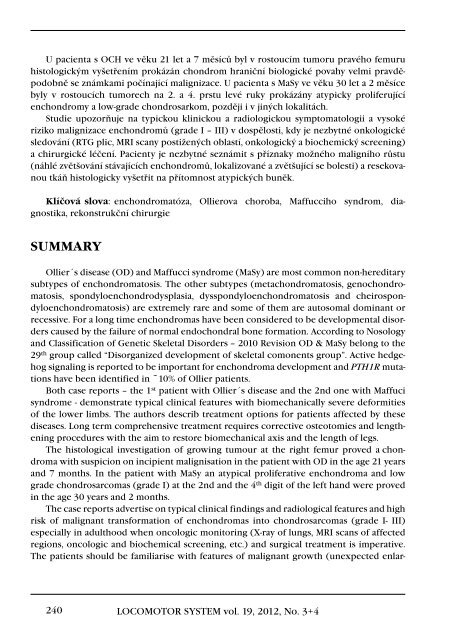3+4+Supplementum/2012 - Společnost pro pojivové tkáně
3+4+Supplementum/2012 - Společnost pro pojivové tkáně
3+4+Supplementum/2012 - Společnost pro pojivové tkáně
- TAGS
- www.pojivo.cz
Create successful ePaper yourself
Turn your PDF publications into a flip-book with our unique Google optimized e-Paper software.
U pacienta s OCH ve věku 21 let a 7 měsíců byl v rostoucím tumoru pravého femuru<br />
histologickým vyšetřením <strong>pro</strong>kázán chondrom hraniční biologické povahy velmi pravděpodobně<br />
se známkami počínající malignizace. U pacienta s MaSy ve věku 30 let a 2 měsíce<br />
byly v rostoucích tumorech na 2. a 4. prstu levé ruky <strong>pro</strong>kázány atypicky <strong>pro</strong>liferující<br />
enchondromy a low-grade chondrosarkom, později i v jiných lokalitách.<br />
Studie upozorňuje na typickou klinickou a radiologickou symptomatologii a vysoké<br />
riziko malignizace enchondromů (grade I – III) v dospělosti, kdy je nezbytné onkologické<br />
sledování (RTG plic, MRI scany postižených oblastí, onkologický a biochemický screening)<br />
a chirurgické léčení. Pacienty je nezbytné seznámit s příznaky možného maligního růstu<br />
(náhlé zvětšování stávajících enchondromů, lokalizované a zvětšující se bolesti) a resekovanou<br />
tkáň histologicky vyšetřit na přítomnost atypických buněk.<br />
klíčová slova: enchondromatóza, Ollierova choroba, Maffucciho syndrom, diagnostika,<br />
rekonstrukční chirurgie<br />
SuMMaRY<br />
Ollier´s disease (OD) and Maffucci syndrome (MaSy) are most common non-hereditary<br />
subtypes of enchondromatosis. The other subtypes (metachondromatosis, genochondromatosis,<br />
spondyloenchondrodysplasia, dysspondyloenchondromatosis and cheirospondyloenchondromatosis)<br />
are extremely rare and some of them are autosomal dominant or<br />
recessive. For a long time enchondromas have been considered to be developmental disorders<br />
caused by the failure of normal endochondral bone formation. According to Nosology<br />
and Classification of Genetic Skeletal Disorders – 2010 Revision OD & MaSy belong to the<br />
29 th group called “Disorganized development of skeletal comonents group”. Active hedgehog<br />
signaling is reported to be important for enchondroma development and PTH1R mutations<br />
have been identified in ~10% of Ollier patients.<br />
Both case reports – the 1 st patient with Ollier´s disease and the 2nd one with Maffuci<br />
syndrome - demonstrate typical clinical features with biomechanically severe deformities<br />
of the lower limbs. The authors describ treatment options for patients affected by these<br />
diseases. Long term comprehensive treatment requires corrective osteotomies and lengthening<br />
<strong>pro</strong>cedures with the aim to restore biomechanical axis and the length of legs.<br />
The histological investigation of growing tumour at the right femur <strong>pro</strong>ved a chondroma<br />
with suspicion on incipient malignisation in the patient with OD in the age 21 years<br />
and 7 months. In the patient with MaSy an atypical <strong>pro</strong>liferative enchondroma and low<br />
grade chondrosarcomas (grade I) at the 2nd and the 4 th digit of the left hand were <strong>pro</strong>ved<br />
in the age 30 years and 2 months.<br />
The case reports advertise on typical clinical findings and radiological features and high<br />
risk of malignant transformation of enchondromas into chondrosarcomas (grade I- III)<br />
especially in adulthood when oncologic monitoring (X-ray of lungs, MRI scans of affected<br />
regions, oncologic and biochemical screening, etc.) and surgical treatment is imperative.<br />
The patients should be familiarise with features of malignant growth (unexpected enlar-<br />
240<br />
LOCOMOTOR SYSTEM vol. 19, <strong>2012</strong>, No. 3+4

















